Aloe Care Health Review 2024
An advanced system of safeguards and communication to protect seniors at-home and on-the-go
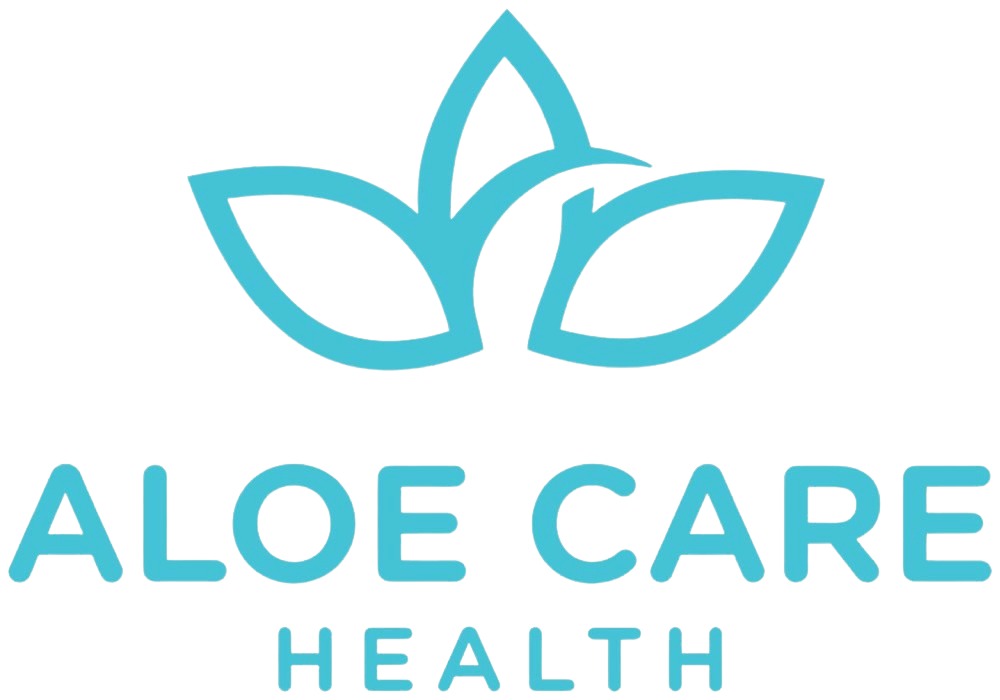
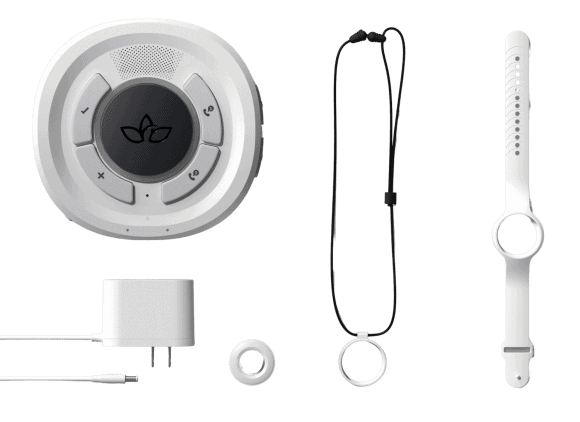
SafeHome.org may receive compensation from some providers listed on this page. Learn More
We may receive compensation from some providers listed on this page. Learn More
An advanced system of safeguards and communication to protect seniors at-home and on-the-go


Aloe Care Health defines itself as a “streamlined communication ecosystem.” It is clear from the start that Aloe Care Health caters to seniors who have family members or friends actively involved in their care.
However, Aloe Care is more than just about looping in caregivers into the response process. Instead, it claims to take into account the needs of both older adults and the needs of caregivers. In this way, Aloe Care Health distinguishes itself from many other medical alert systems on the market. Oh, and it claims it’s “The world’s most advanced medical alert system.” Does it live up to its promises?
We spent several days getting acquainted with the Aloe Care Health Essentials Plus system, which contains both in-home and away-from-home monitoring. We think you’ll agree that while it is not head of the class in a few categories, there is a lot to love about this system. In the areas that Aloe Care Health places their focus, they do things really well. So without further ado, let’s get started!
Check out more recommendations from the SafeHome team:
The smallish size of the box that the package arrives in belies the number of pieces of equipment that comes with this medical alert system. As we mentioned above, Aloe Care Health Essentials Plus is a dual system; that is, it includes devices for monitoring both at home and while away from home.
When reviewing medical alert systems, we always try to test out their product that include both types of monitoring, as in most cases, this “system” is actually their in-home and on-the-go systems bundled into one. That is the case with the Aloe Care Health Essential Plus.
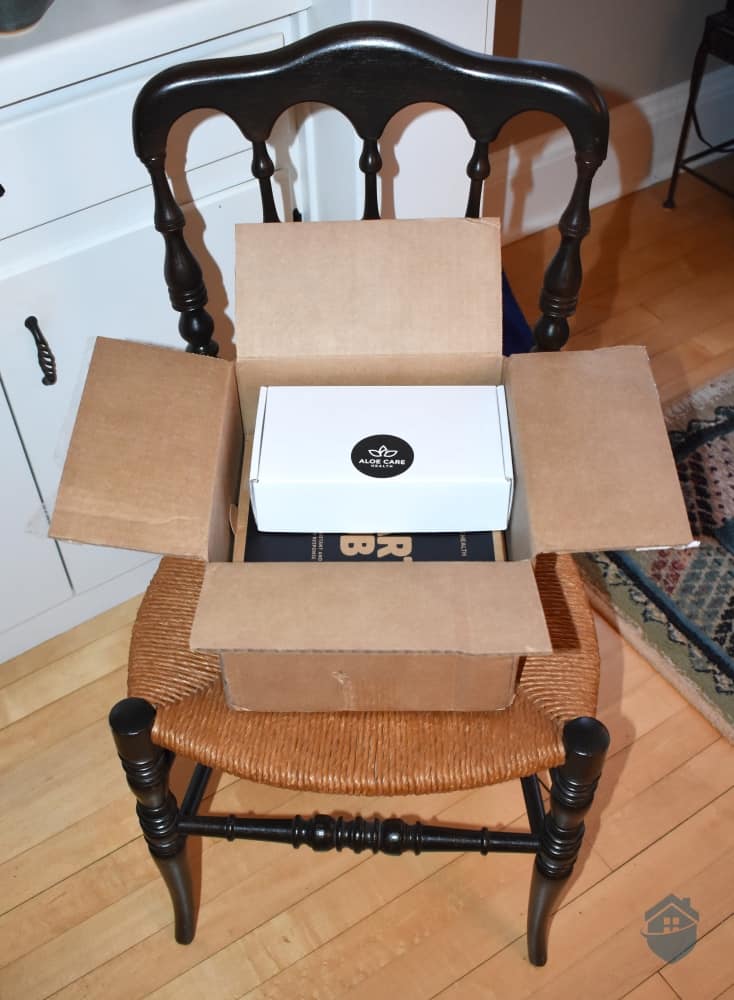
Unboxing Aloe Care Health
We tackled the in-home system first. We were curious about the flying saucer-looking base unit and all of its accessories. We weren’t the only ones. As we emptied the box of each of the pieces for “The Smart Hub,” our cat climbed into the cardboard box behind us to watch.
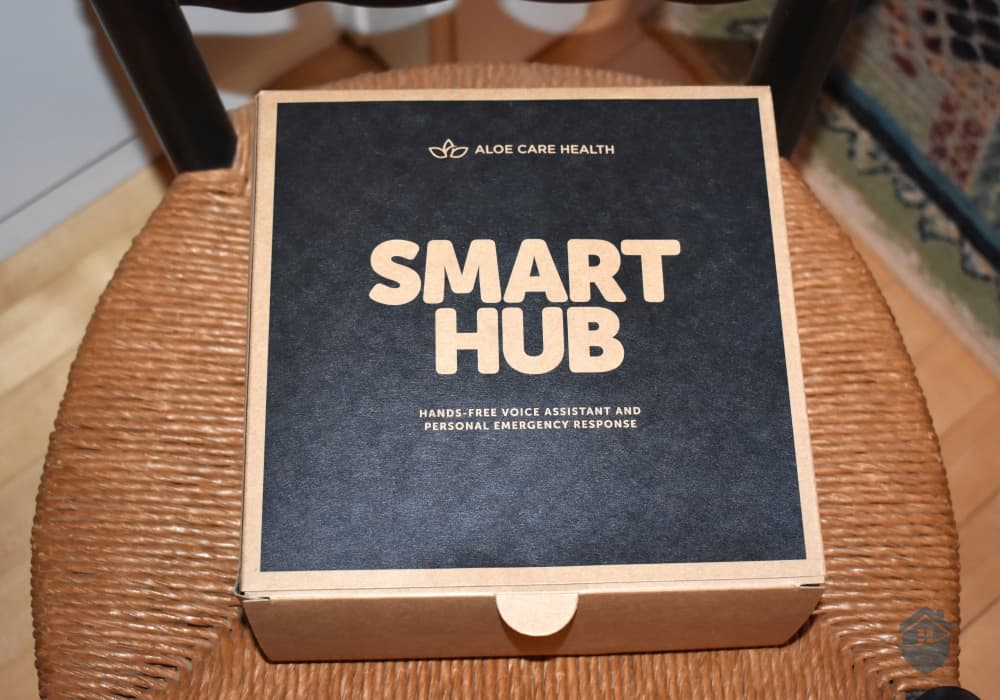
Aloe Care Health Smart Hub Box
The In-Home System included the following pieces:
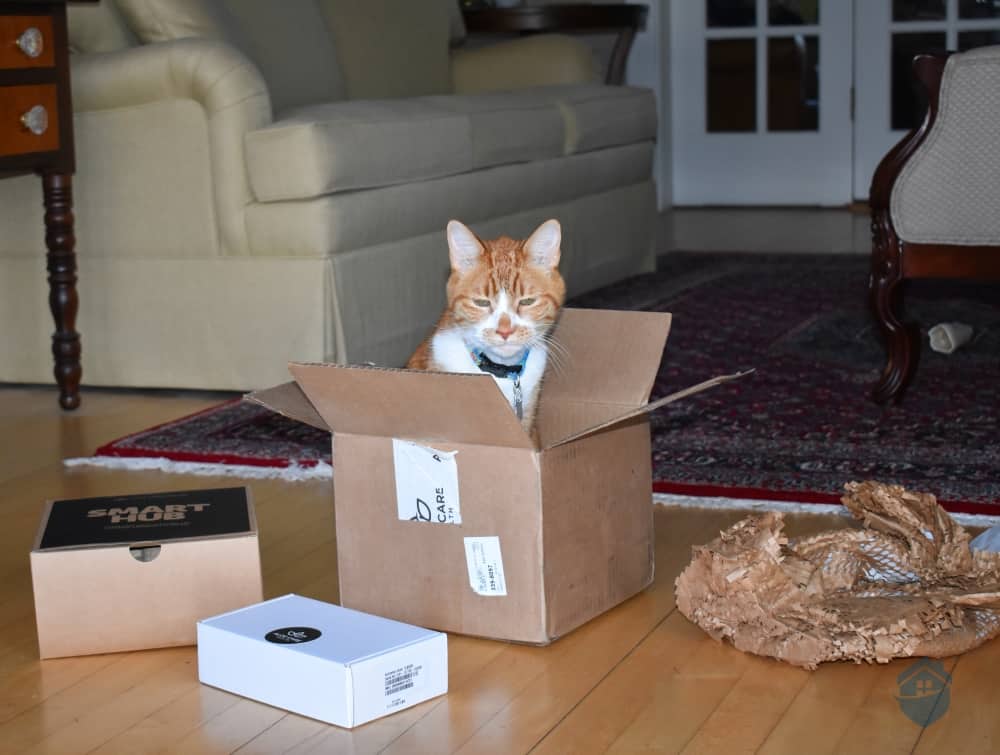
Unboxing the Aloe Care Health System
After shooing away our cat and reclaiming the box for future packaging in the case of a return, we turned towards the box for the mobile system. It contained:
Phew! A total of eight pieces of equipment and five instructional booklets. If it is a simpler system with fewer pieces that you’re looking for, we recommend reading our Bay Alarm Medical SOS Smartwatch review. That one contains just five pieces of equipment for the same setup as the Aloe Care Health.
That said, we actually felt like we were getting our money’s worth with all of this Aloe Care Health equipment, so no complaints here. For now, let’s find a spot for everything and dig in.
It’s all about location. We know what this means in real estate. But what does it mean in the world of medical alert devices? The base unit should be placed in a central location where the user spends the majority of their time.
Is she a baker? The kitchen may be the best spot. A couch potato? Maybe try the living room. Someone who spends lots of time on the computer? How about the office or den.
Fun Fact: According to the Choice Home Warranty survey, when asked which room of the house Americans value the most, 28% of respondents indicated the kitchen and another 28% indicated the living room.
Keep in mind that Aloe Care Health recommends placing the unit away from a water fixture, direct sunlight, a TV, speaker, or a heating or cooling element. It should be placed on a flat surface within five feet of an outlet and, because of motion sensors on the front of the unit, three to four feet from the ground.
That’s a lot to consider for a device we typically just set up anywhere convenient to us, but that’s the tradeoff for having as many features as the Aloe Care base station. We’ll get to those later on.
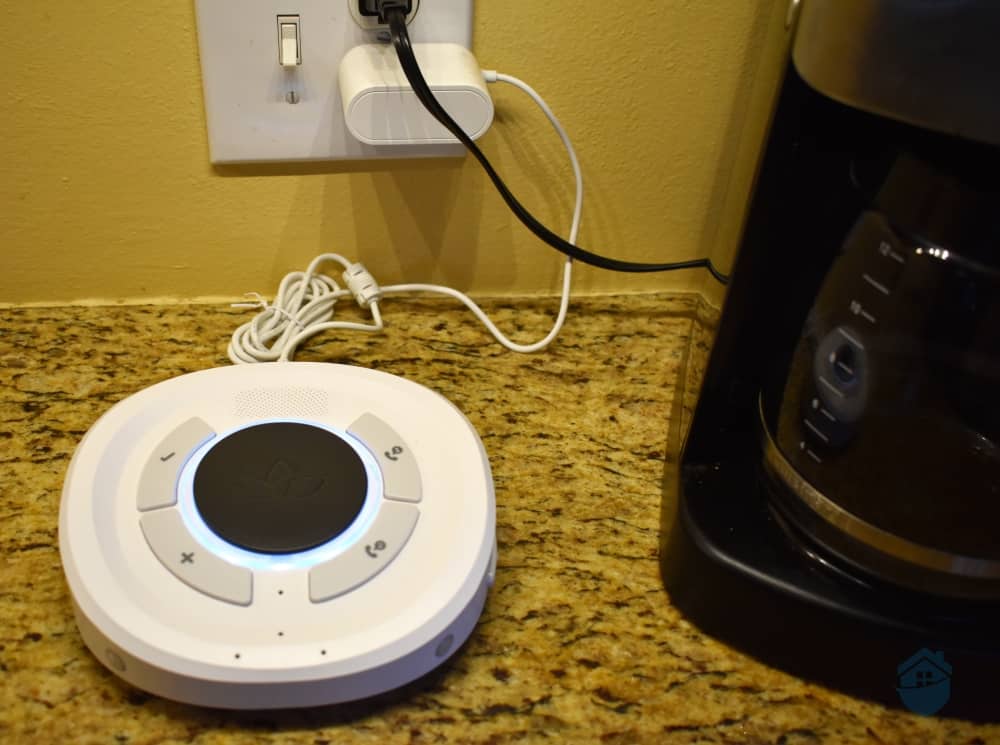
The Aloe Care Health Smart Hub
We placed our Smart Hub in the kitchen, which is Central Command in our house. After choosing our ideal spot, we began reading the
“Basic Set Up” guide. The directions were pretty straightforward and contained photographs to confirm what the device should look like when plugged in. Towards the end of the guide, seniors are directed to complete the set up themselves while caregivers are directed to proceed to Booklet 2, “Connect for Caregivers.” We liked the group effort.
We were immediately informed that connecting to the Internet is simple but optional, as Aloe Care Health uses a 4G LTE cellular signal to function. This is definitely something that we wanted to know and were glad that it was front and center. We’ve found that cellular connections are superior to Wi-Fi connections because Wi-Fi could cut off any moment, while cellular signals are more reliable. Still, if you want to connect it to Wi-Fi, that’s an option; 4G LTE will serve as backup. Kudos to Aloe Care Health here.
Once we got past the fact that it looked like a miniature UFO had landed on our counter, we observed that the Hub contains more features than the base units of many other systems.
A help button – that large, black, circular thing at the center – is front and center. Pressing this will connect the elderly user to the monitoring center and send out alerts to caregivers.
To the right are two check-in request buttons, which sends out alerts to a caregiver. For individuals with more than one caregiver, the button with the numbered “1” pings the primary caregiver while the one numbered “2” alerts all caregivers. Note that these buttons won’t connect the user to the monitoring center, which is a great feature, because not every event is call-the-medics worthy.
To the left of the help button are two buttons marked with a check mark and an X. These buttons are used to deny or accept incoming check-in requests from caregivers as well as confirm or cancel a help request from the senior. They can also be used to answer “yes” or “no” to the voice assistant living inside the unit.
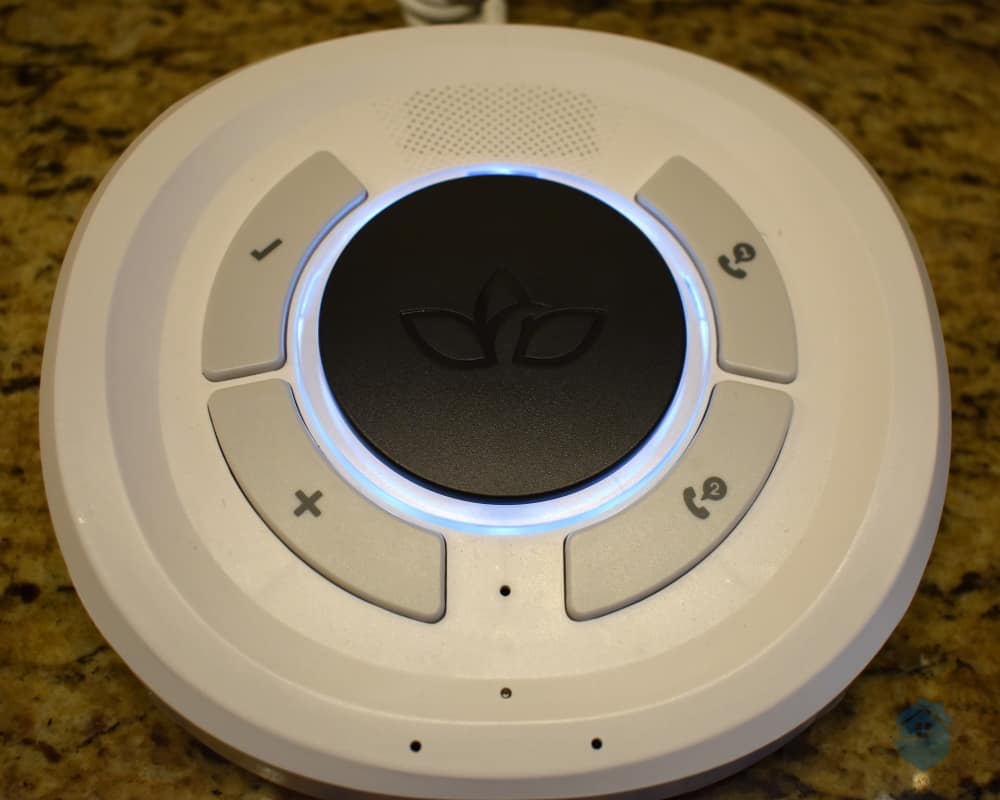
Closeup of the Aloe Care Health Smart Hub
With this variety of features, you or your loved one can request emergency help either through pressing a button or speaking towards the unit. Note that calls can be cancelled if necessary, and calls with caregivers can be initiated and continued through the base unit.
Pro Tip: If trying to connect with the emergency response center through voice activation, say, “Emergency!” repeatedly until the voice assistant responds.
Did you know that in 2020, 50 million, or one in five, Americans provided unpaid care to another adult?1 This number will continue to grow as more Baby Boomers age. Aloe Care Health focuses on the critical needs of these caregivers.
We found the caregiver app to be an integral piece to this medical alert system. A quick glance at the dashboard on our iPhone informs us that the indoor temperature is 71 degrees, and the air quality is good. We have never seen this type of information communicated in other systems. It could alert caregivers to potentially unhealthy environmental conditions.
Scrolling down, we can see the user’s recent movement. For example, when we were moving around within the range of the Smart Hub, the feed on the app read, “Jenny was moving in the kitchen at 10:46 AM.” A lack of movement might communicate that we need to check in on our older loved one. This type of caregiver insight can be absolutely life-saving.
Pro Tip: When caregivers check in, the Smart Hub plays a short ditty and the ring light blinks blue. This adds a little transparency and serves as a warning to the virtual “visit.”
The app also enables everyone in “the care circle” to message back and forth with each other. For example, if we were scheduled to drive Aunt Helen to a doctor’s appointment but have a work commitment so need a substitute, we could send one quick message through the app that would reach all of the caregivers. Great functionality here.
Another function at your fingertips is the ability to click on one button and either call the senior’s phone or the SmartHub device.
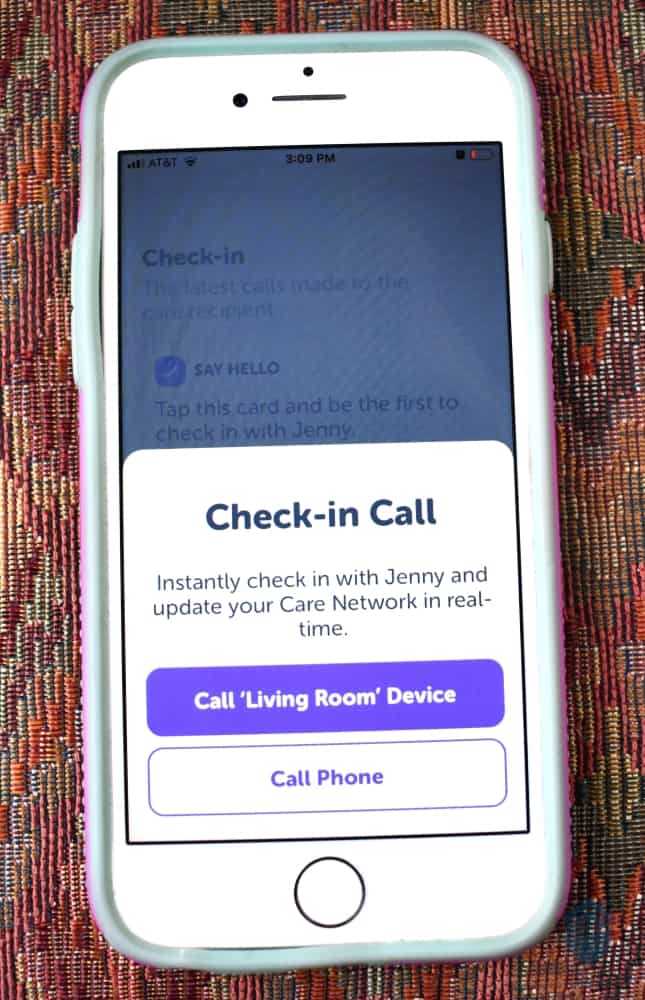
Aloe Care Health Check-in Call
The “Health Card” on the app stores information that could prove useful to anyone making an emergency call. It includes any lockbox or key code and information on pets in the home, pre-existing medical conditions, allergies and medications – all information that would aid an EMT arriving at your loved one’s home.
One other offered function that we think has immense potential is the Smart Apps integration. A multitude of smart devices and appliances can be purchased to help keep your loved one safe while aging in place. This includes smoke detectors, water leak sensors, intrusion sensors, stove monitors, and more.2 Any of these smart devices can also be integrated to the caregiver’s app, allowing for central control by all caregivers. Pretty neat! Of course, we recommend that any decisions made on monitoring an individual’s house be made in conversation with the senior who lives there.
If you or your older loved one doesn’t need (or want) this level of monitoring, you may want to take a look into our review of Lifeline, which also offers an app for caregivers, just without all the advanced functionality. But honestly, we think many of these features will help to keep your loved one safe and sound.
Here’s how we envision the Smart Hub operating at its best. Betty, who lives by herself and is aging in place, is in her kitchen cooking dinner. Her oldest daughter, designated as the primary caregiver, pushes the app call button on her iPhone. Betty, who is stirring her soup, can answer the call by simply saying “hello.” The SmartHub is placed on a nearby countertop.
Her daughter asks about Betty’s day and learns that Betty has been experiencing some flu-like symptoms. After discussing it, they decide that they should keep their eyes on the symptoms and make a doctor’s appointment in the morning if the symptoms persist. As Betty gets ready to eat, her daughter reminds Betty to make sure the stove is turned off.
After they disconnect, Betty’s daughter quickly makes a note of their conversation and sends it through the app to the secondary caregivers. In this fictional scenario, Betty is safe in her own home, all of her caregivers have been informed of what could turn into a potential health concern and her family members have renewed peace of mind as they proceed with their own home and family responsibilities.
Looking Ahead: Aloe Care Health is working on adding an important feature to its system – conference calls. Ask about it when inquiring about Aloe Care Health Medical Alert systems.
Keep in mind that the Smart Hub only has a 10-foot range for voice activation. For us, the voice activation reached through our kitchen and into the adjoining family room. It did not reach either of the front rooms of our house, the basement, second floor, driveway or backyard. While the Hub was placed in the room where we spend most of our time, it doesn’t reach the spaces where we spend all of our time.
The care button, with the accompanying lanyard or watch, is intended as a back-up for when the older adult is outside of the voice activation range. We recommend that the older adult wear the help button consistently every day. It can be worn in the shower, but it will not function outside. This wouldn’t be an issue for us; when we are collecting mail or doing yardwork, we could simply wear the mobile device. However, it could be an issue if you are considering the Essentials package which does not include a mobile device.
We also want to point out that the care button does not have two-way talk. (This is standard for wearable help buttons.) Though unable to speak to a response center associate through the care button, the important safety mechanism, a direct channel to signal for help, is still in place. If the user pressed the care button during an emergency, yet was too far away to speak into the Hub, the caregivers and emergency services would be contacted.
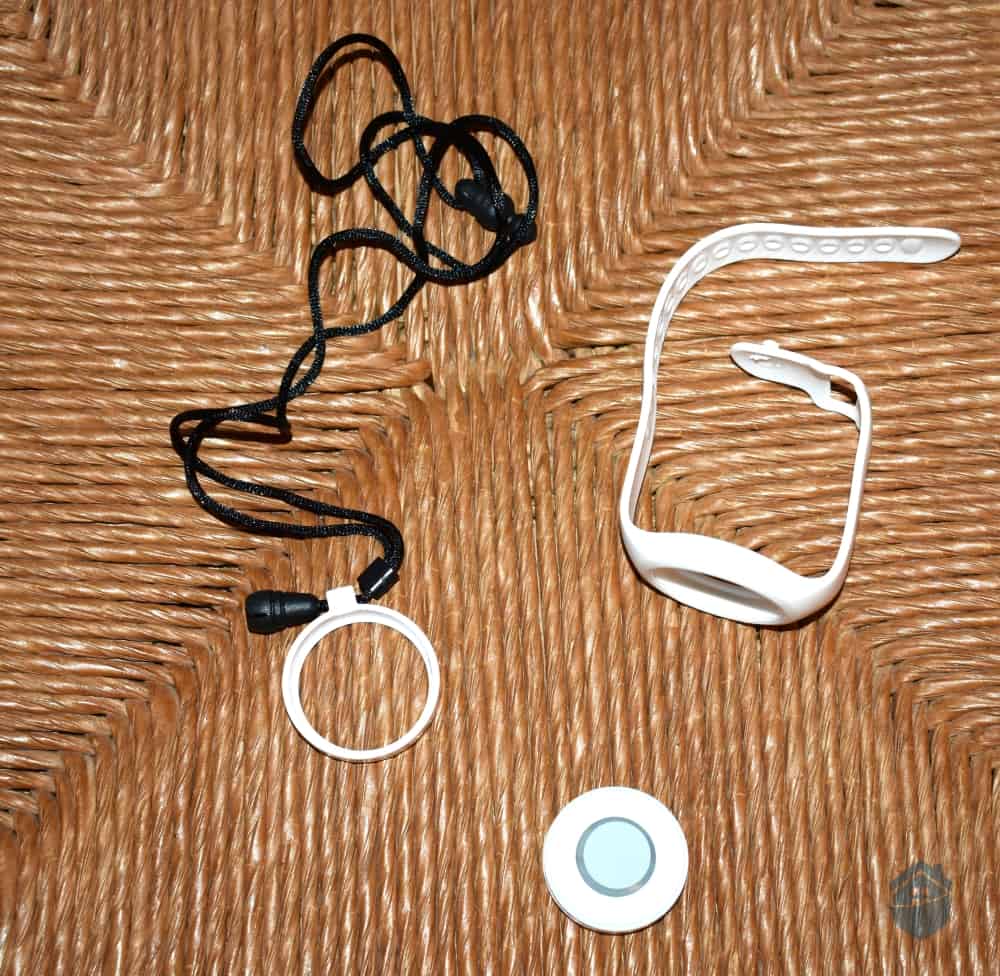
Aloe Care Health Wearables
Although we think it is important, the help button is presented as an optional item. To be honest, it seemed like an afterthought, as both the lanyard and watch attachments are on the flimsy side. It also lacks fall detection, something other alert systems include on their in-home pendants. Still, we like that something has been included to extend the Hub’s 10-foot range.
If you or a loved one has fallen before or has a medical condition that increases the risk of falling, you may want to consider Lifeline HomeSafe with AutoAlert which includes fall protection in their in-home wearable device.
Another option for those who don’t mind paying a little extra is the Aloe Care Health Total Care package. This package includes everything in the Essentials Plus package but includes a fall detection sensor for the bathroom as well as two additional motion sensors.
Finally, an important element of any medical alert system is the response time. This is the amount of time between requesting help by pressing the button or using the voice activation and the moment that the emergency response team connects with the user.
We tested the Aloe Care Health system several times, and the average response time was 49 seconds, only slightly slower than the industry average of 40 seconds. Is it a deal-breaker? Not really. We would say that anything over 1 minute is a deal-breaker, but 49 seconds is really not bad.
Moving a little further from the in-home unit, let’s talk about the Aloe Care Health Mobile system that was included in our Essential Plus package.
The mobile button operates like many others on the market in that it has multiple, valuable features like GPS location detection, fall detection and two-way talk. It also has a few additional features that many other options on the market do not have. For example, on one side is a shield button that can be used to test the device, check the battery, or cancel requests.
It also provides multi-sensory (sight, sound, and vibration) feedback for users who have difficulty seeing, hearing, or both. Aloe Health Care really shines when it comes to inclusivity here. One minor issue, however, is that with all those feedback options, it might take time for an aging adult to memorize what they all mean. The company encourages caregivers to spend some time making sure the adults in their care understand how the feedback systems work.
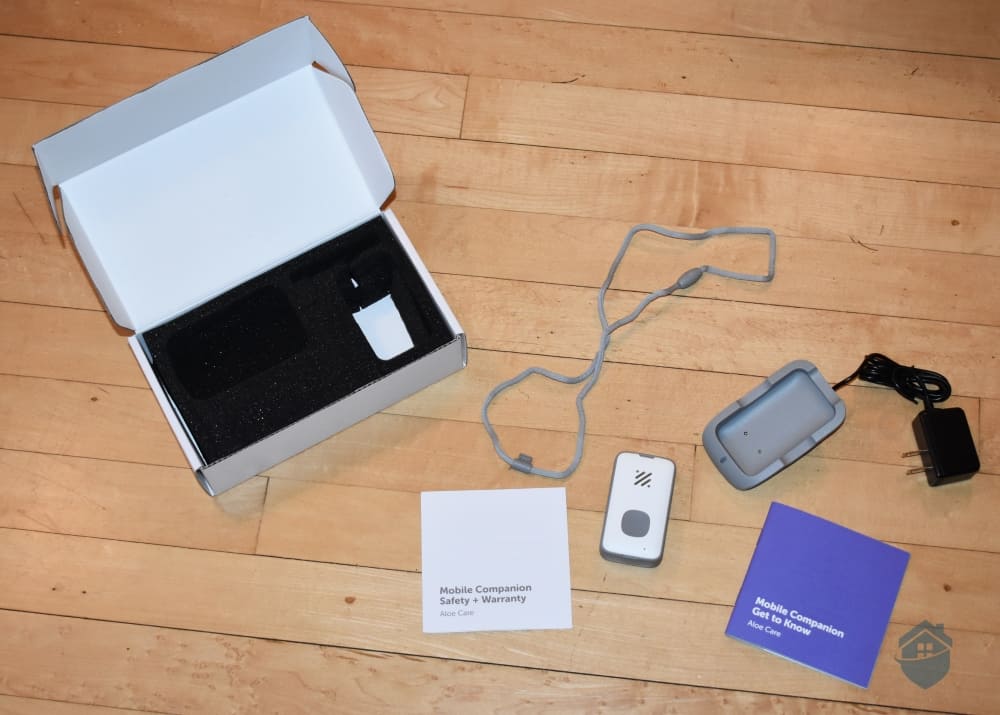
Unboxing the Aloe Care Health Mobile System
In addition, using the app, caregivers can identify the user’s location. Not found in all medical alert systems, this feature is important, particularly with dementia patients or for someone who may fall and hit their head, resulting in unconsciousness or confusion. Some seniors momentarily lose consciousness prior to a fall. In fact, this occurs more frequently than most people realize. Location detection for caregivers is a beneficial extra layer of protection.
Did You Know? The prevalence of Syncope (a faint due to a reduction in the blood supply to the brain) increases with age and impacts an astounding 20% in those aged 75 and older.3
We had our first opportunity to test the mobile companion late one afternoon while out and about doing errands.
Worn around the neck, the device is rectangular in shape (3 inches x 1 ¾ inches). Because it has a depth of ¾ inch, it is on the boxy side and also somewhat heavy when worn for an extended time around the neck.
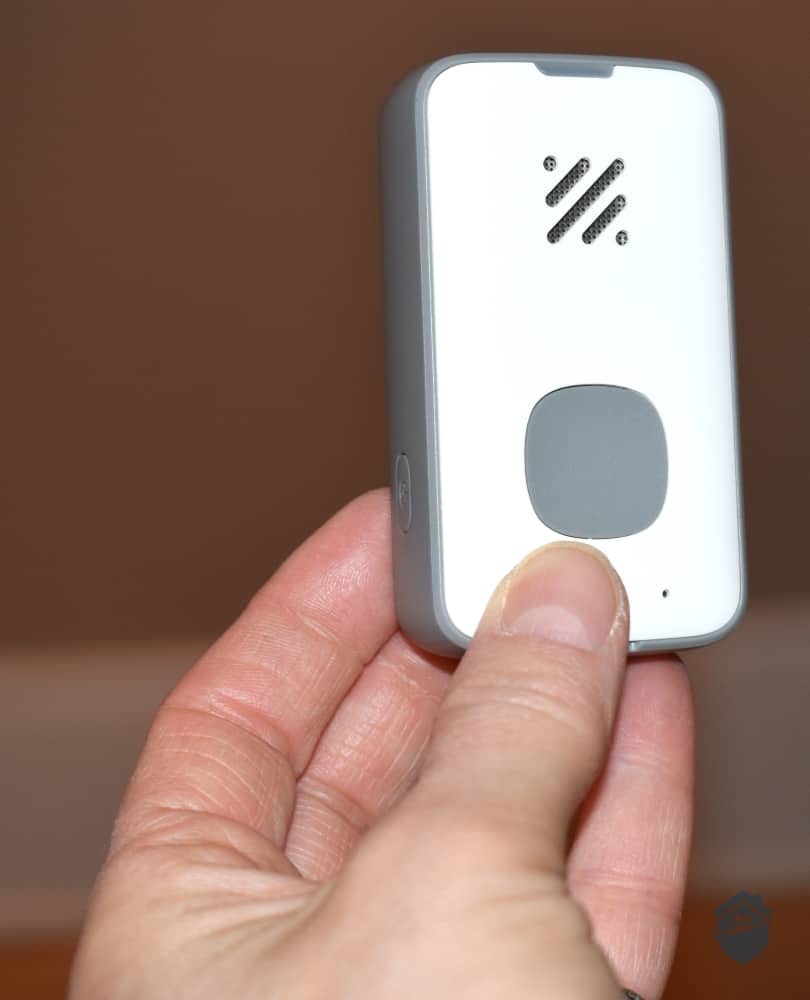
Aloe Care Health Mobile System
To indicate that the mobile companion is on and the battery level is healthy, a light at the top of the device blinks green every 30 seconds. A blinking blue light indicates a low battery level while a blinking red light indicates that the help button has been pushed. While the blinking lights offer strong communication, we didn’t like the idea of turning into a beacon while at the grocery store. Tucking the device under a coat or scarf in the winter is easy enough, but in the summer the blinking beacon will be more obvious.
We are happy to report that we did not experience any false alarms with Aloe Care Health, something that can happen with fall detection technology. And we were able to observe how the device can be tracked through the caregiver’s app. This is a huge advantage.
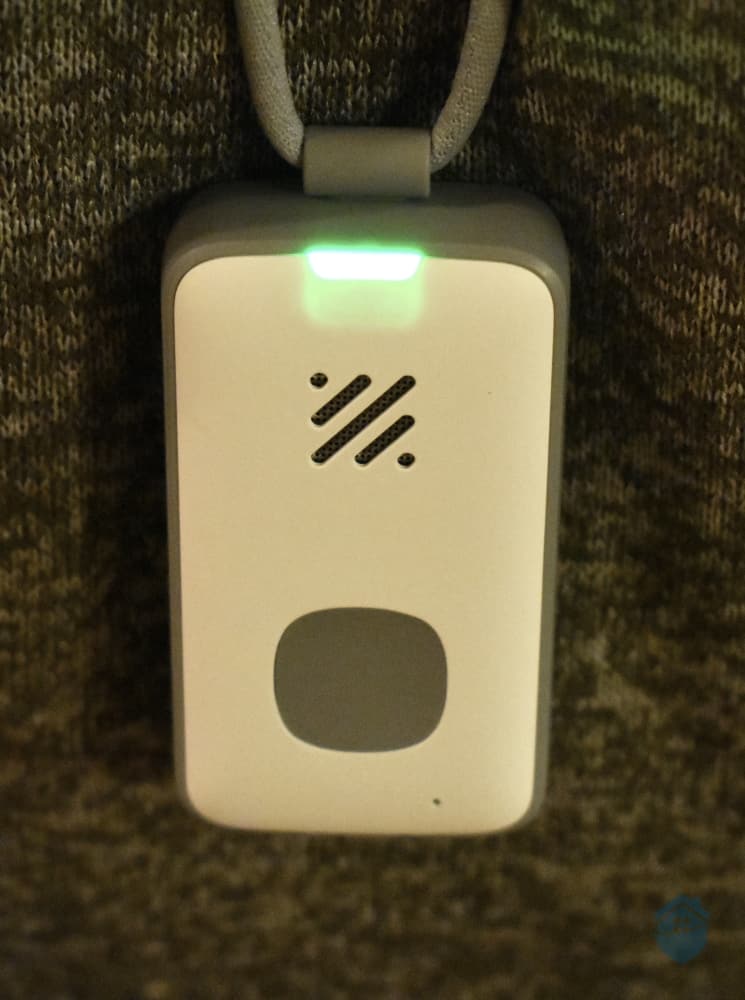
Closeup of Aloe Care Health Mobile System
Aloe Care Health really provides thorough protection with its mobile companion, going above and beyond the offerings of some of the other brands of mobile alerts out there. But with its not-so-subtle design, the only question is whether older adults will feel comfortable wearing it while out.
If the design of a mobile device is a priority for you, you may want to check out our Medical Guardian review. It offers an on-the-go device that is smaller and lighter.
The monthly fee for a medical alert system averages between $20 and $40. Often, this price is for a single system – either an at-home or a mobile system. The Essentials Plus system is a dual system; it offers coverage at-home and away. And it comes in at a monthly price of $39.99 per month. We think this is a pretty good bargain for a system that provides both in-home and on-the-go coverage.
Now for the equipment cost. At $249.99, it is not a small expense, especially for someone on a fixed income. But with the Smart Hub, you are getting a device that provides multiple high-level functions, some not offered by other companies. We always like to point out when a company does not tack on extra fees for things like installation, activation, or shipping and handling. Aloe Care Health does not do this, so what you see, pricewise, is what you get.
Aloe Care Health does offer three packages. Essentials Plus (the one we reviewed here) is the middle-tier system. For a look at how it compares in price and features to the other two tiers, take a look at our chart below.
| Essentials | Essentials Plus | Total Care | |
|---|---|---|---|
| Monthly Fee | $29.99 | $39.99 | $49.99 |
| Equipment Cost | $149.99 | $249.99 | $349.99 |
| Includes Smart Hub & Help Button | Yes | Yes | Yes |
| Includes Mobile Companion | No | Yes | Yes |
| Automatic Fall Detection in Bathroom | No | No | Yes |
| Additional stand-alone motion detectors beside the Hub | No | No | Yes |
We also like that Aloe Care Health offers a 30-day risk-free trial. You will have to sign up and pay for all the initial expenses (first monthly fee and equipment fee), but within 30 days, you can return the system and get your money back if it doesn’t work out for you.
While a trial period like that isn’t unique to Aloe Care Health, we think this is important for a system that offers as many features as the Smart Hub. This is a relatively high-tech medical alert system, and for seniors who are tech-averse, this might turn out not to be the right choice. With the 30-day trial, you can find out for yourself without guessing.
We had several questions about the Aloe Care Health Essentials Plus system including the Smart Hub which wasn’t cooperating with us in the beginning. In the end, we think it may have been user’s error. (Ours, not theirs!)
After contacting their customer service, we waited 10 minutes with elevator music playing in the background after moving through the automated system. We have found that this is not unusual for customer service at companies that provide medical alert systems. It usually means that when it is your turn, you will get undivided attention and thorough assistance.
What we appreciated was being asked after 10 minutes if we wanted to leave our names and phone number for a call back. We did. Unfortunately, we were told, it could take up to 48 hours. For us, it only took two.
And we did get professional service when we received the call back. We called a second time, and this time we only waited five minutes. Heidi, the customer service representative, was polite, patient with us, and she thoroughly answered all of our questions.
As far as customer service goes, Aloe Health Care can be a mixed bag, but overall, once you get in touch with them, their customer service makes the grade.
Aloe Care Health captures a unique niche within the medical alert system industry. They have wisely designed a system that has all the hallmarks of a successful care plan involving an entire care team: several layers of protection, solid communication, and a holistic approach to safeguarding our loved ones’ well being.
There are so many things to like about this system, but we are going to leave the best for last, and point out a few of the drawbacks first. We know from experience that no one likes being “spied on” or having others “poke their nose in their business.” The Aloe Care Health System may be perceived by some as doing just that.
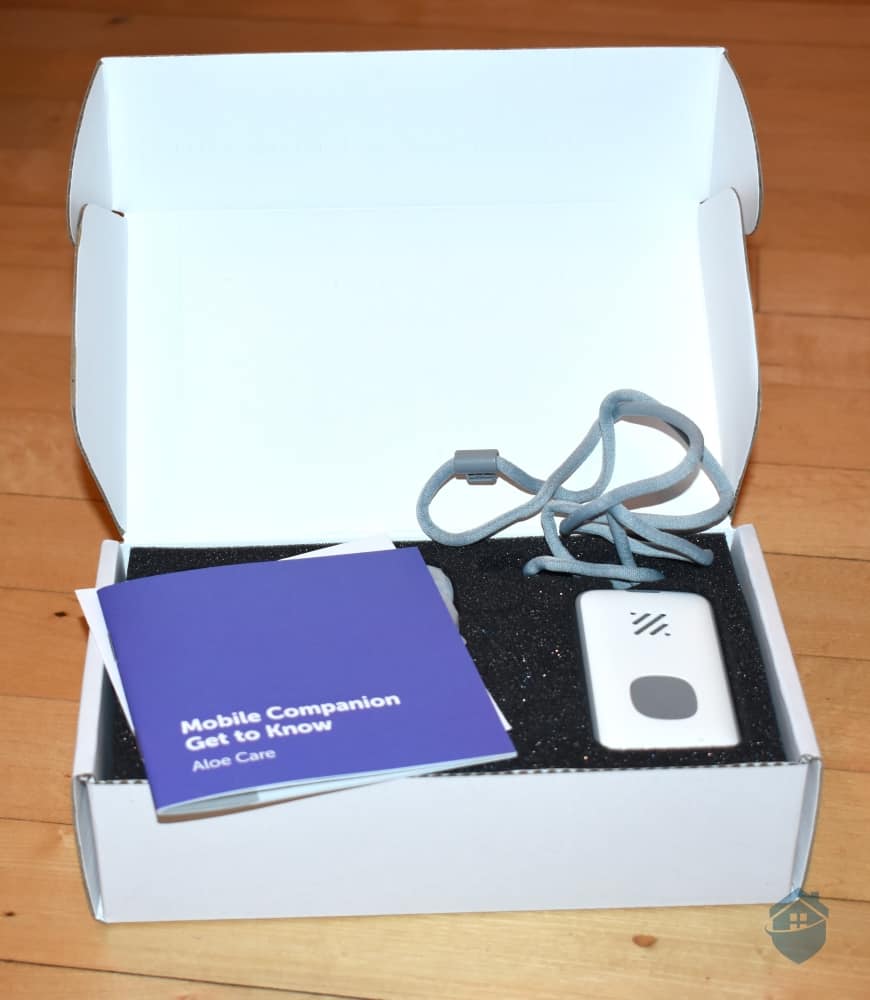
Aloe Care Health Packaging
Some older adults live independently, have few or no medical conditions and want a medical alert system “just in case.” These are the seniors who might do just fine with a lower level of monitoring, like we found when we reviewed One Call Alert. The Aloe Care Health system would be advantageous for those with more serious medical conditions as well as individuals who are more advanced in age.
We would also recommend it for those who have dementia. (However, those with advanced stages of dementia will need a higher level of care.) The GPS feature in the mobile unit and the motion sensors in the Smart Hub can help caregivers monitor the movement of the seniors in their care. Plus, the caregiver app really takes caregiving to a whole new level – you don’t have to be physically around to gain insights like air quality and temperature in your loved one’s home. It might also be useful for remote caregivers, caregivers who have another job, and families with multiple caregivers. This covers a lot of ground!
The other potential issue is that it is a somewhat complicated system. It was initially fun to open up the package and pull out all of the different accouterments. The thrill may dim when it comes to juggling the different devices. The success of the system will require wearing the care button even though the majority of the action will take place through the Smart Hub. The older adult will also need to remember to swap the care button for the mobile companion when leaving home, even if just to go to the backyard. They will then need to remember to charge the mobile companion daily. You will need to evaluate whether this is practical for you or your loved one.
No system is perfect, but we think that for many older adults and their caregivers, Aloe Care Health offers a product that provides great protection and some really unique features not found elsewhere. Research shows that caregivers have a high level of stress, working caregivers especially so. Nearly one in four caregivers reports that their situation is highly stressful, and an additional 28 percent report moderate stress.4
The ability to easily communicate with a loved one, other caregivers and the response center is a big advantage. So too is the ability to read real-time feedback from a loved one’s home. Much of the time this feedback could be mundane information that after a quick look will provide peace of mind. In the event that emergency assistance is needed, the pieces are in place to ensure that it arrives swiftly. So for these reasons and more, we can confidently recommend Aloe Care Health for seniors.
The only way for a caregiver to contact the response team is through the Caregiver’s App. This is called an elevated check in. If, after checking in with your loved one through the app you think emergency help is needed, you can press the emergency button to connect with the response center.
The care button has already been pre-paired to the Smart Hub. No additional steps need to be taken. Just attach it to the watch or lanyard and you are ready to go.
Press and hold the shield button on the side of the device. After a chime, a battery status message will be given. Also, when charging the device, a solid blue light indicates that the battery is charging. A solid green light indicates that the battery is fully charged. The mobile companion should be charged daily.
They will indicate if there is an elevated level of carbon dioxide (CO2) or volatile organic compound (VOC) in the home. Both are known indoor pollutants that can create adverse health effects including eye, nose, and throat irritation; nausea; headaches and loss of coordination; damage to the liver, kidney and central nervous system; and cancer.
The sensors do not monitor carbon monoxide (CO).5
If you want to cancel a call after either activating the care button or the Smart Hub, simply go to the Smart Hub and either press the X button or say “Cancel.” If you do not do either of these actions in time, simply tell the response team that you are cancelling the call when they connect.
AARP.org. (2020, June 18). 1 in 5 Americans Now Provide Unpaid Family Care.
https://www.aarp.org/caregiving/basics/info-2020/unpaid-family-caregivers-report.html
Dwell.com. (2019, Feb. 13). 9 Smart Home Devices for Aging in Place.
https://www.dwell.com/article/9-smart-home-devices-for-aging-in-place-5528881a
Journal of Geriatric Cardiology. (2016, July). Retrieved from National Center for Biotechnology Information. Syncope in Older Adults.
https://www.ncbi.nlm.nih.gov/pmc/articles/PMC4984568/
Research report from the National Alliance for Caregiving. (2020, May). Caregiving in the U.S. 2020.
https://www.caregiving.org/caregiving-in-the-us-2020/
Epa.gov. (2017, Nov. 6). Volatile Organic Compounds Impact on Indoor Air Quality.
https://www.epa.gov/indoor-air-quality-iaq/volatile-organic-compounds-impact-indoor-air-quality